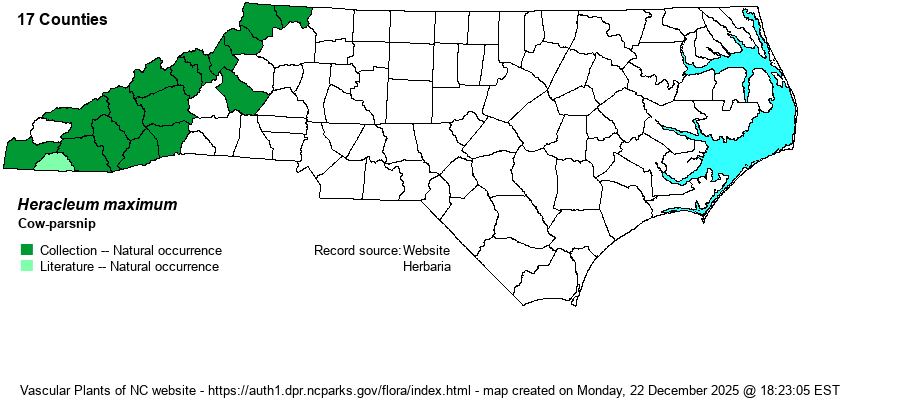| Author | W. Bartram | |
| Distribution | Throughout the Mountains; apparently not present into Piedmont foothills.
This is a widespread Northern species, ranging south to NJ, PA, MO, and CA, and down the Appalachians to northern GA. | |
| Abundance | Infrequent to fairly common, from higher elevations to lower ones in river valleys. Somewhat less numerous in the far southwestern counties. | |
| Habitat | This species occurs in rich, often moist soil, though it is not a strict wetland plant. It is often found in wet meadows, along creek banks and riversides, and other lowlands; however, it also grow in openings and edges of rich upland forests, and even around grassy balds (with seepage). | |
| Phenology | Blooms from May to July, and fruits from July to August. | |
| Identification | This is about as robust as any native herbaceous species -- perhaps along with Common Pokeweed (Phytolacca americana)-- in the state. It has a thick and hollow stem (to 2 inches wide), grows to about 6-7 feet tall or more, has a rank smell, and has a woolly or very hairy stem. The scattered, alternate stem leaves are very large (1-foot long or more), divided into 3 large maple-leaf segments, each about 6 inches across. The several umbels, one at the summit and a few from leaf axils, are compound, with 15-30 umbellets, each on long rays, and with many small white flowers comprising each of these small umbellets. The entire umbel can be 5-6 inches across. Though not common, when you spot this monster of an herb, it should be obvious by its large maple-leaf leaflets, thick and hispid stem, and large umbels. | |
| Taxonomic Comments | Many references name or named this species as H. lanatum.
| |
| Other Common Name(s) | Common Cow-parsnip, Indian Celery | |
| State Rank | S3 | |
| Global Rank | G5 | |
| State Status | | |
| US Status | | |
| USACE-agcp | FAC link |
| USACE-emp | FAC link |

